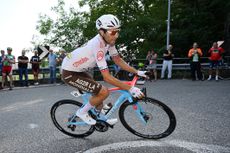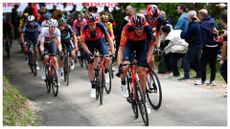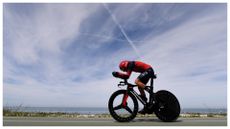Cycling’s hidden under-fuelling epidemic: here’s how to spot the signs of RED-S and make sure you’re meeting your energy demands
The prevalence of under-fuelling in both professional and amateur cycling is shockingly widespread - many may not be aware of the damage they’re causing their bodies
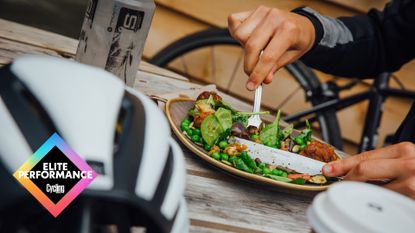
- What is RED-S?
- Why is under-fuelling prevalent in cycling?
- RED-S and under-fuelling statistics in cycling
- How do I know if I have RED-S and if I am under-fuelling?
- Common symptoms of RED-S and under-fuelling
- Getting diagnosed with RED-S
- Screening for risk of RED-S
- How is RED-S managed?
- Can Continuous Glucose Monitors help identify under-fuelling?
Kristen Faulkner's disqualification from the Strade Bianche Donne podium this year for wearing a continuous glucose monitor (CGM) during the race, along with statements from both Faulkner and Supersapiens post-race, has reignited the topic of under-fuelling in performance sports.
We’ll take you through everything you need to know about energy deficiency in sport, its prevalence across both amateur and professional athletes (which is shockingly high, especially when you consider the likely extent of underreporting) and how to spot the signs in yourself - as well as ensuring you’re getting the right balance of energy for the intensity of your training.
Under-fuelling in cycling: what is RED-S?
Simply put, RED-S refers to when an athlete is not eating enough to cover normal physiological processes and the amount of training being undertaken.
RED-S is short for Relative Energy Deficiency in Sport, and is defined by the International Olympic Committee (IOC) as “impaired physiological functioning caused by relative energy deficiency and includes, but is not limited to, impairments of metabolic rate, menstrual function, bone health, immunity, protein synthesis and cardiovascular health.” The underlying factor leading to these impairments is Low Energy Availability (LEA), where an athlete has inadequate energy available to meet basic physiological needs.
The term replaces the ‘Female Athlete Triad’, which is the inter-relationship between disordered eating, menstrual dysfunction, and low bone mass, acknowledging that the condition affects both men and women, and that it involves a whole spectrum of issues rather than just these three components. RED-S is a broader, more comprehensive term describing the overall syndrome that results from energy deficiency in any athlete.
Why is under-fuelling prevalent in cycling?

Energy availability is the energy (calories) you have left after you subtract the calories you expend during your training from the calories you consume in your diet for the day. If you do not have enough energy left to fuel your body’s physiological functions, you will have low energy availability which could lead to RED-S over time.
Low energy availability (LEA) is not always intentional or related to disordered eating.
Intentional LEA occurs when athletes restrict their dietary intake to control body weight and/or body composition. It can occur in the presence of disordered eating but also without. That being said, it is more likely to occur in sports where power to weight or aesthetics tend to be prioritised or there are weight classifications (eg. gymnastics, ballet, rowing, running, cycling, etc.)
Body image concerns, social or external pressures (eg. parents. coaches), misplaced dieting programs, and common myths or traditional beliefs and practices (such as “eating is cheating”) can each lead to intentional LEA.
On the other side of things, unintentional LEA occurs when riders are not meeting the energy demands of cycling. This is often due to a lack of awareness of their energy mismatch, or lack of knowledge regarding cycling nutrition and eating. That being said, there are other factors that can contribute to this, including insufficient finances, low appetite, exclusion diets (eg. gluten-free, vegetarian diet, etc), logistical issues and busy, time-poor athletes.
It can also occur during periods of increased training volume or intensity or when engaging in sports with high energy expenditure. Endurance cycling poses a high risk for LEA and RED-S as it can be both power to weight related and involve long training hours with high energy expenditure.
I spoke to Zwift Academy finalist Imogen Alton who suffered from RED-S for much of 2022, despite having prior knowledge and experience of the condition.
“I had experienced RED-S before as a light-weight rower and had learnt about it during my university studies (Exercise and Nutrition Sciences),” Imogen explains. “I had been hyper-cautious of not under-fuelling as I knew the risks and the consequences. I was incredibly frustrated to have put myself in that position again and risk my health and performance.
“Although my symptoms presented in January of 2022, I believe I had been experiencing RED-S shortly after my mum passed in July of 2021. I trained to cope with her passing away, and had a significantly reduced appetite as a result of grief.”
Just how prevalent is RED-S and under-fuelling in cycling?
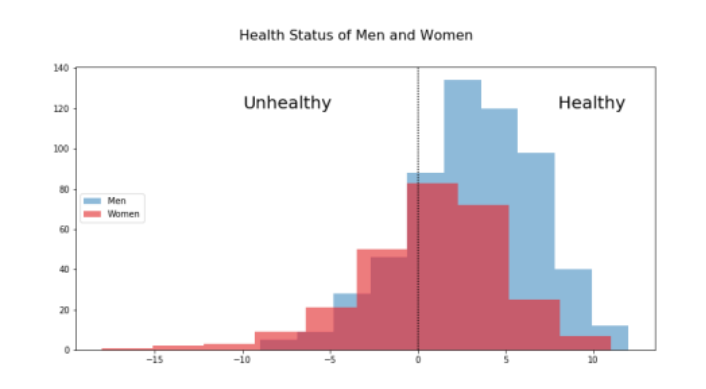
The CW survey showed a surprising number of riders in the unhealthy zone, using criteria set by experts in endocrynology
30% of female respondents and 15% of males exhibit symptoms of RED-S, according to a Cycling Weekly reader survey we ran in 2020. The number increased to 40% and 36% in semi-professionals, the highest risk group. In female cyclists who were not on hormonal contraception, 39% reported menstrual dysfunction, with gaps in menstruation of longer than six months up to 20 years.
Research studies show prevalence estimates of LEA, which underpins RED-S, of approximately 22% to 58% across a variety of sports. Others have found the risk of LEA ranges from 14% to 63%. LEA and RED-S is thought to be highly prevalent in athletes and likely underreported due to difficulties in diagnosis and agreement on energy availability values.
This under-reporting may be more prevalent in males as there is no overt sign of period loss like in females, men may be less likely to speak about body image issues, and the culture of sport doesn’t invite men to speak openly about what may be perceived as weaknesses.
How do I know if I have RED-S and if I am under-fuelling?

RED-S will have an adverse effect on both health and performance through its negative effect on a wide range of body systems. When in a state of LEA, the body will conserve energy for essential functions, suppressing resting metabolic rate and shutting down processes not critical for short term survival such as reproduction and bone turnover.
The health consequences seen in RED-S include the original concepts of menstrual dysfunction and bone health, but also have broader endocrine (hormonal) and metabolic effects, growth and development disruptions, cardiovascular system disturbances, gastrointestinal slowing, haematological and immunological adaptations, and mental health disorders.
In terms of performance, energy is required to fuel working muscles, for growth and adaptation of the cardiovascular and muscular system, and for recovery for subsequent training sessions. Without sufficient energy availability, there will be an inability of the body to adapt to training stimulus to improve performance.
Common symptoms of RED-S and under-fuelling

Some common symptoms of RED-S that are worth looking out for include:
- Change in weight (often an increase due to the body going into survival mode, slowing metabolism and conserving body fat)
- Menstrual disturbances (irregular or loss of periods)
- Loss of or lowered libido, loss of morning erections in men
- Recurrent injury with prolonged recovery
- History of fractures, either traumatic or stress fractures (due to low bone density)
- Recurrent illness (e.g. colds and flu)
- Unexpected fatigue (can also be related to iron deficiency)
- Deterioration in performance or failure to improve
- Decreased muscular strength, endurance, and coordination
- Inability to maintain consistent training
- Disrupted sleep patterns
- Gastrointestinal issues eg. nausea, vomiting, diarrhoea, abdominal pain, bloating
- Change in mood, anxiety, depression, reduced social interaction
- Poor relationship with food
- Reduced motivation to train
Many of these symptoms are ones which Imogen experienced when she was suffering from RED-S: “I had amenorrhoea (loss of periods), low iron levels, low vitamin D, osteopenia, and I gained a significant amount of weight in an incredibly short amount of time.”
“I had completely lost any capacity to push hard, no matter how ‘recovered’ I was before performing the effort,” she recalls. “My ability to repeat efforts, and concentrate during races was significantly thwarted.
“Additionally, my readiness and motivation to train had dwindled, my overall mood was incredibly low, I felt extreme lethargy and low-energy, and felt as though I was functioning at 50% capacity at all times.”
Getting diagnosed with RED-S

Athletes displaying a number of the symptoms listed above require further investigation. RED-S is essentially a diagnosis of exclusion, with other medical conditions that can cause similar symptoms needing to be ruled out.
There is difficulty in defining and diagnosing LEA (which underpins RED-S) because of limitations in calculating LEA well. Recording or measuring EI in real life can present a challenge, as it is usually done retrospectively, can result in under or over reporting, and may encourage obsessive behaviour or further disordered eating,
There are however some useful clinical markers that can assist in diagnosis. Suppressed thyroid function can be an early sign of LEA state. Suppression of other hormones, such as oestrogen, testosterone and other sex hormones, will appear later. Cortisol (stress hormone) levels may be raised.
Other blood markers include low iron/ferritin, vitamin D and B12 deficiency and decreased white blood cell count.
Measuring resting metabolic rate (RMR) - actual RMR as a percentage of predicted RMR - can indicate a state of LEA as this will decrease as the body goes into “survival” mode in an attempt to conserve energy for essential bodily functions.
A DEXA scan (Dual Energy X-ray Absorptiometry) to detect low bone mineral density compared to normal reference levels can also assist in diagnosis.
Screening for risk of RED-S
Questionnaires can be a useful, convenient, and relatively simple method for screening or early detection of LEA/RED-S. However, they should not serve as diagnostic tools. The ‘Low Energy Availability in Females Questionnaire’ (LEAF-Q) is the most widely validated, along with the ‘Eating Disorder Examination Questionnaire’ (EDE-Q) which can be used to assess risk in both sexes.
A Clinical Assessment Tool (RED-S CAT) was developed by the IOC in 2015, which separated athletes into high risk, moderate risk, and low risk categories in relation to an athlete's medical risk of continuing in sport.
It is especially important to identify athletes at risk in their adolescent years, a time of growth and development with increased nutritional demands. It is also the peak bone building years where you acquire your bone mineral density for life.
Imogen also shares some practical advice in regards to self-monitoring for signs of RED-S: “I advise women to track their period and take note of any changes to the duration of their cycle or the level of their flow. Any subtle change is worth noting, and reflect on how your fuelling before, during, and after training has been recently.
“Also utilising a wellness or readiness journal and note how motivated you feel to train, how well you slept, how recovered you feel, how you felt during your session, and how your energy levels felt during the day.”
How is RED-S managed?
Treatment of RED-S involves a multidisciplinary approach, with the ultimate goal of increasing energy availability by increasing energy intake and decreasing energy expenditure through modification of nutrition, training load and recovery. The expertise of a Sports Dietitian and Sports Physician will be valuable.
Imogen’s road to recovery focussed on increasing energy availability under medical supervision: “For me we took the extreme approach and reduced training to essentially nothing and almost tripled what I was eating.
"I had to get repeat bloods done to look at my cortisol levels to ensure my body was returning to a 'non-stressed' state, I had fasting blood glucose tests done, and had to have repeat resting metabolic scans to ensure my metabolism was increasing and I was returning to normal.”
Can Continuous Glucose Monitors help identify under-fuelling?

Continuous Glucose Monitors (CGM) provide users with near-real time monitoring of interstitial glucose data.
The initial focus of CGM use in sport was to meet carbohydrate availability goals of exercise and maintain optimal glucose levels during training, hence improving performance. Manufacturers such as Supersapiens, have since promoted their use for health reasons rather than just performance, with the potential for monitoring energy availability status.
Following Kristen Faulkner's disqualification from Strada Bianche, Supersapiens released a statement regarding this issue:
"We request that the UCI start to see CGMs and Supersapiens as a tool for athletes to protect their bodies, not as some sort of performance enhancement device. This isn't about going faster. This is about health.
“Supersapiens invites the UCI to work together… with the goal of designing science-based best practices for optimising nutrition and recovery and mitigating eating disorders."
Faulkner shared her disappointment in the UCI's decision to DQ her from Strade Bianche, and has listed multiple studies on her twitter feed stating how women are more susceptible to hypoglycaemia at certain phases of their menstrual cycle, and how low glucose levels in women are more likely to be associated with menstrual dysfunction.
She has also stated: “I hope that one day glucose monitors are allowed in racing. I believe they are a valuable tool for athletes - especially women - to take care of their physical health.”
However, only a small number of studies have looked at athletes' glucose response to carbohydrate intake during endurance activities using CGM-derived glucose data, mainly due to its recent advent.
Kristina Skroce, Head of Research at Supersapiens, acknowledges this: “There is not enough research available at the moment. We need time to ensure studies are validated, reliable and peer-reviewed. There are some waiting to be published, including four recent lab-based studies.”
“In the meantime, we are working closely with a number of athletes and they are reporting that CGMs are helping them to fuel properly by gaining an insight into what they are eating and monitoring energy levels. Many have reported losing weight despite eating more.”
There have been laboratory studies that show a trend towards an increase in hypoglycaemic episodes, both during training and at night, following acute periods where energy expenditure exceeds energy intake, and thus may be an important early warning sign that LEA is disturbing metabolic homeostasis.
Further research with larger sample sizes is recommended to evaluate the value of CGMs in detecting LEA, and to understand the reliability and validity of CGM data before we can be certain that this information is meaningful to athletes.
Kristina also agrees with this, adding: ”Glucose sensitivity is highly individual, so athletes need to use CGMs for at least a month to identify meaningful trends, and attest whether glucose data will help them to identify energy deficiency.”

Thank you for reading 20 articles this month* Join now for unlimited access
Enjoy your first month for just £1 / $1 / €1
*Read 5 free articles per month without a subscription

Join now for unlimited access
Try first month for just £1 / $1 / €1
Get The Leadout Newsletter
The latest race content, interviews, features, reviews and expert buying guides, direct to your inbox!
Nicole Oh is a physiotherapist and bike fitter, with training in biomechanical assessments, sports injury rehabilitation, acupuncture and clinical pilates.
A competitive cyclist with a background in triathlon, Nicole raced at National level in the UK, also managing and co-founding the Les Filles Racing Team. Having moved to Sydney, she works as a physiotherapist at The Body Mechanic and continues to race competitively.
-
 Larry Warbasse claims what could be the world's toughest Strava KOM
Larry Warbasse claims what could be the world's toughest Strava KOMThe 89.5km Mauna Kea climb in Hawaii rises from sea-level to 4,214 metres with steep gravel sections on the way
By James Shrubsall Published
-
 ‘We need to honour her memory’ - Melissa Hoskins’ parents pay tribute after Olympian’s tragic death
‘We need to honour her memory’ - Melissa Hoskins’ parents pay tribute after Olympian’s tragic deathFamily and former teammates mourn loss of Australian cyclist
By Tom Davidson Published
-
 Five nutrition questions answered by an Ineos Grenadiers expert
Five nutrition questions answered by an Ineos Grenadiers expertWe put some hot fuelling topics to Dr Marc Fell, performance nutritionist for Ineos Grenadiers
By Sponsored Published
-
 Eating for optimal recovery
Eating for optimal recoveryHow INEOS Grenadiers use Science in Sport to fuel their recovery
By Sponsored Published
-
 What to drink when cycling - the liquids you need on the bike
What to drink when cycling - the liquids you need on the bikeNot all liquid is created equal - we explain the different types of fluid that'll help you ride further
By Luke Friend Published
-
 Ask a coach: 'I’m over 40, what is a good VO2 max for my age?'
Ask a coach: 'I’m over 40, what is a good VO2 max for my age?'VO2 max measures how much oxygen your body can utilise in a minute - but how does yours compare to the average, and does it matter?
By James Spragg Published
-
 Performance fuelling for time-trials.
Performance fuelling for time-trials.How INEOS Grenadiers use Science in Sport to fuel a Grand Tour stage when every second counts
By Sponsored Published
-
 Fuelling for the mountains
Fuelling for the mountainsHow INEOS Grenadiers use Science in Sport to fuel a Grand Tour
By Sponsored Published
-
 Should cyclists care more about chemicals in sports nutrition?
Should cyclists care more about chemicals in sports nutrition?With so much information now available about sports nutrition, how can athletes make sense of what’s best for them? We chat with two brands and a registered dietitian to get to the bottom of what formulas make sense and why
By Kristin Jenny Published
-
 Are these six common sports nutrition rules fact or fiction?
Are these six common sports nutrition rules fact or fiction?By Adam Becket Published
